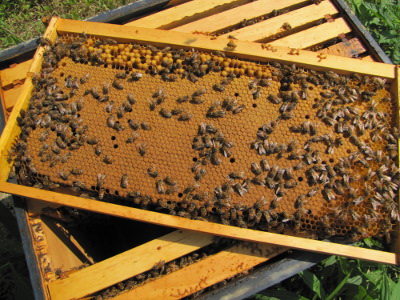
Backyard bee breeding
One of the main thrusts
of Michael Bush's book is --- backyard beekeepers of every experience
level need to be breeding homegrown bees. With diseases and pests
wiping out colonies left and right, we can't risk narrowing the gene
pool by letting a few big companies breed all of our queens, and we
shouldn't even use our single favorite queen as the mother of every new
hive in our apiary. Meanwhile, we should try to include the
survivor genetics of feral bees, letting our queens mate with wild
drones and allowing queens of captured swarms to maintain control of
their colonies.
 But the reproduction of bee
hives is quite complex, as my swarming post probably made
clear. Do we need fancy equipment and a PhD to raise our own
queens? Although Michael Bush does go into some production
methods that felt beyond me, he also mentioned very simple breeding
techniques for those of us who aren't obsessed with maximum
productivity.
But the reproduction of bee
hives is quite complex, as my swarming post probably made
clear. Do we need fancy equipment and a PhD to raise our own
queens? Although Michael Bush does go into some production
methods that felt beyond me, he also mentioned very simple breeding
techniques for those of us who aren't obsessed with maximum
productivity.
Remember how I split my
hive this past spring?
Splitting by the box (one full box of brood in each daughter hive) is
indeed the easiest way to double your number of hives with very little
work. If you put ten deep frames or sixteen medium frames of
brood and honey in each daughter hive, both hives will take off so
quickly that you might be able to split the hives again before the year
is out. Those of you with several hives can take a single frame
of brood and a frame of honey from each of your strong hives and create
a new hive in this manner without setting the parent hives back much at
all.
 Smaller
splits are handy for raising queens --- a useful technique for the more
advanced apiarist who wants to replace ornery or failing queens with
daughter queens from a stronger and nicer hive. For these splits,
Bush recommends having some nucs on hand. Nucs are smaller boxes
--- often just big enough to hold two, three, four, or five frames ---
that keep the workload down for small colonies of bees. You might
put one frame of brood and one frame of honey in a two frame nuc, then
add the tiny colony to a queenless hive once the nuc has raised a
queen. Alternatively, you could put three frames of brood and two
frames of honey in a five frame nuc, then transfer the new colony to a
normal sized brood box to create a new hive once the queen is laying.
Smaller
splits are handy for raising queens --- a useful technique for the more
advanced apiarist who wants to replace ornery or failing queens with
daughter queens from a stronger and nicer hive. For these splits,
Bush recommends having some nucs on hand. Nucs are smaller boxes
--- often just big enough to hold two, three, four, or five frames ---
that keep the workload down for small colonies of bees. You might
put one frame of brood and one frame of honey in a two frame nuc, then
add the tiny colony to a queenless hive once the nuc has raised a
queen. Alternatively, you could put three frames of brood and two
frames of honey in a five frame nuc, then transfer the new colony to a
normal sized brood box to create a new hive once the queen is laying.
When's the best time to
split? Beekeepers have a saying that you can either produce lots
of new hives, or make lots of honey, but not both. If you split
hives before the main nectar flow, the bees can use all those blooms to
create a strong colony that will make it through the winter with no
help from you...but you probably won't be able to harvest any
honey. On the other hand, if you let the parent hive collect lots
of honey during the main nectar flow, then split them, you might end up
having to feed the daughter hives to make sure they have enough winter
stores. As with any other part of beekeeping, you have to decide
how much to focus on the health of the bees, and how much to focus on
your own stomach.
| This post is part of our The Practical Beekeeper lunchtime series.
Read all of the entries: |
Want more in-depth information? Browse through our books.
Or explore more posts by date or by subject.
About us: Anna Hess and Mark Hamilton spent over a decade living self-sufficiently in the mountains of Virginia before moving north to start over from scratch in the foothills of Ohio. They've experimented with permaculture, no-till gardening, trailersteading, home-based microbusinesses and much more, writing about their adventures in both blogs and books.
Want to be notified when new comments are posted on this page? Click on the RSS button after you add a comment to subscribe to the comment feed, or simply check the box beside "email replies to me" while writing your comment.


Anna, all your stuff on bees lately jogged my memory of a piece of poetry,which I went in search of today. It's by Kahlil Gibran, and it's in The Prophet:
And now you ask in your heart, "How shall we distinguish that which is good in pleasure from that which is not good?"
Go to your fields and your gardens, and you shall learn that it is the pleasure of the bee to gather honey of the flower,
But it is also the pleasure of the flower to yield its honey to the bee.
For to the bee a flower is a fountain of life,
And to the flower a bee is a messenger of love,
And to both, bee and flower, the giving and the receiving of pleasure is a need and an ecstasy.
Beautiful poem!
I know everyone's probably sick of bees --- I'm going to give them a rest for a while. I've just been wanting to figure out our spring campaign and thought I'd share my research.